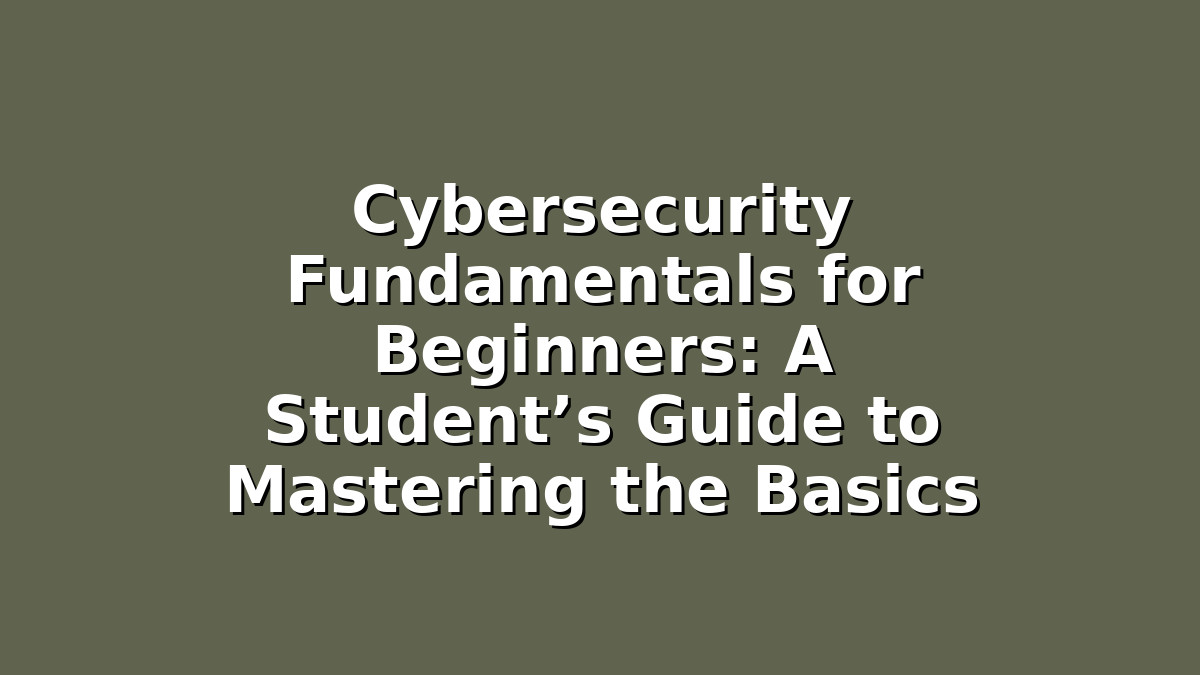In today’s digital age, cybersecurity has become an essential field not only for professionals but also for students preparing for exams or wanting to build a strong foundation in technology. Whether you’re studying computer science, information technology, or simply interested in protecting your online presence, understanding cybersecurity fundamentals is crucial. This guide will walk you through the basics of cybersecurity and provide effective study tips tailored for students who want to excel in this dynamic subject.
Introduction
Cybersecurity refers to the practices, technologies, and processes designed to protect computers, networks, and data from unauthorized access or attacks. As more aspects of life and business move online, the importance of cybersecurity grows exponentially. For students, mastering cybersecurity fundamentals can open doors to exciting career opportunities and help safeguard personal information against cyber threats.
Preparing for exams or gaining proficiency in cybersecurity can seem overwhelming given the technical jargon and vast scope of the field. However, breaking it down into manageable sections and using smart study strategies can make learning both enjoyable and effective. In this article, we will explore three key areas: understanding core cybersecurity concepts, practical study techniques, and applying knowledge through hands-on practice.
—
1. Grasping Core Cybersecurity Concepts
Before diving into complex topics, it is essential to familiarize yourself with basic cybersecurity terms and principles. This foundation will make advanced topics more accessible and help you confidently approach exam questions or projects.
Key Concepts to Study:
– Confidentiality, Integrity, and Availability (CIA Triad): These are the three pillars of cybersecurity. Confidentiality ensures that sensitive information is accessed only by authorized users. Integrity guarantees that data remains accurate and unaltered. Availability ensures that systems and data are accessible when needed.
– Types of Cyber Threats: Learn about malware (viruses, worms, ransomware), phishing, social engineering, denial-of-service attacks, and insider threats. Understanding how these threats operate will help you recognize potential risks.
– Authentication and Authorization: Know the difference between verifying a user’s identity (authentication) and granting permissions (authorization). Familiarize yourself with common methods like passwords, biometrics, and multi-factor authentication (MFA).
– Firewalls and Encryption: Firewalls act as barriers between trusted and untrusted networks, while encryption protects data by converting it into unreadable code. Both are fundamental tools in cybersecurity.
– Common Security Policies and Best Practices: Understand basic guidelines such as strong password creation, regular software updates, and safe browsing habits.
Study Tip: Create flashcards with these terms and definitions. Regularly reviewing flashcards can reinforce your memory and make recalling concepts during exams easier.
—
2. Effective Study Techniques for Cybersecurity Students
Learning cybersecurity is not just about memorizing terms; it requires critical thinking and problem-solving skills. Here are some proven study methods to help you absorb and retain cybersecurity knowledge more effectively.
1. Use Visual Aids and Mind Maps
Cybersecurity involves interconnected concepts. Visual tools like flowcharts, diagrams, and mind maps help you see relationships between ideas. For example, mapping out how a phishing attack works or how encryption secures data can deepen your understanding.
2. Break Down Complex Topics
Don’t try to learn everything at once. Divide subjects into smaller chunks — for instance, study network security one day and malware types the next. This approach reduces overwhelm and improves focus.
3. Practice Active Learning
Engage actively with the material by summarizing information in your own words, teaching concepts to a friend, or answering practice questions. This boosts comprehension and retention.
4. Schedule Regular Study Sessions
Consistency is key. Set aside dedicated time each day or week for cybersecurity study. Short, frequent sessions tend to be more effective than long, infrequent ones.
5. Use Online Resources and Forums
There are many free resources available such as cybersecurity tutorials, videos, and quizzes on platforms like Cybrary, Coursera, and YouTube. Additionally, participating in forums like Stack Exchange or Reddit’s r/cybersecurity allows you to ask questions and learn from peers.
—
3. Applying Knowledge Through Hands-On Practice
Cybersecurity is a highly practical discipline. Applying what you learn through real-world exercises can deepen your understanding and prepare you for exams that include scenario-based questions or labs.
1. Set Up a Virtual Lab
Using virtual machines (VMs) or cybersecurity simulation platforms lets you experiment safely without risking your own system. Tools like VirtualBox or VMware allow you to create an isolated environment to practice tasks such as installing firewalls, launching simulated attacks, or analyzing malware samples.
2. Participate in Capture The Flag (CTF) Challenges
CTFs are cybersecurity competitions where participants solve security puzzles ranging from cryptography to network exploitation. Many beginner-friendly CTFs exist online, and they provide an engaging way to learn problem-solving skills and test your knowledge.
3. Install and Use Security Tools
Familiarize yourself with common cybersecurity software like Wireshark (network protocol analyzer), Nmap (network scanner), and antivirus programs. Understanding how these tools work helps you appreciate how security professionals defend networks.
4. Secure Your Own Devices
Practice good cybersecurity habits on your personal devices: use strong passwords, enable two-factor authentication, update software regularly, and avoid suspicious links or downloads. This hands-on approach reinforces theoretical knowledge.
5. Join Cybersecurity Clubs or Online Communities
Many schools and universities have cybersecurity clubs where students collaborate on projects and share tips. Online communities also offer mentorship and group learning opportunities. Being part of a community motivates you and exposes you to diverse perspectives.
—
Conclusion
Mastering cybersecurity fundamentals as a beginner may feel challenging, but with the right approach, it can be a rewarding journey. Start by understanding the essential concepts, use effective study techniques to build deep knowledge, and apply what you learn through practical exercises. Remember, cybersecurity is not just about memorizing facts; it’s about developing a mindset of vigilance, problem-solving, and continuous learning.
Stay curious, stay persistent, and don’t hesitate to seek help when needed. Your efforts will pay off not only in exams but also in building a valuable skill set for the future. Embrace the challenge, and you’ll find cybersecurity becoming an exciting and empowering subject.

Responses